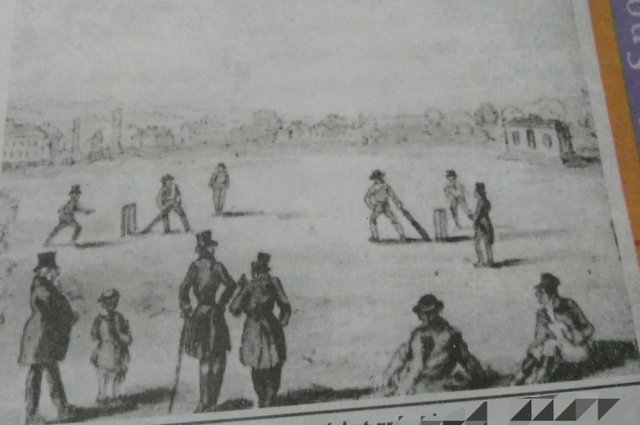HISTORY AND ABOUT THE GAME OF CRICKET.
"Hello friends, in this post I am going to tell you about Cricket and some history of Cricket."
.jpeg)
THE STORY OF CRICKET
Cricket was invented in England and became intimately link to the culture of 19th century Victorian society. The game was respected to represent all England valued; fairplay, discipline and gentlemanliness. With the British, cricket spread to the call colonies. It was supposed to uphold the values of Englishness also. The colonial master assumed that only they go to play the game as it ought to be played in its spirit.

The game of Cricket thus got linked up closely with the politics of colonialism and nationalism. Within the colonies of the British, the game had a complex history. It was connected to the politics of cast and religion, community and nation. The emergence of cricket as a national game was the result of many decades of historical development.
Cricket grew out of the many stick-and- ball games played in England 500 year ago, under a variety of different rules. The word 'bat' is an old in English word that simply means stick or club.
By the 17th century, cricket had envolved enough to be recognisable distinct game. Till the middle of the 18th century, bats were roughly the same shape as hockey sticks, carving outwards at the bottom. There was a simple reason for this, the ball was bowled underarm, along the ground so the curve at the end of the bat gave the batsman the best chance of making contact.
.jpeg)
LAWS OF CRICKET
The first written Law Of Cricket were drawn up in 1774. These laws stated that ' the principles shall choose the gentleman from amongst present two umpires who shall, absolutely decide all disputes. The stumps must be 22 inches high and bail across them 6 inches. The ball must be between 5 to 6 ounces and the two sets of stumps should be 22 yards apart'. There was no limits on the shape or size of the bat.
.jpeg)
THE SPREAD OF CRICKET
Some English team games like hockey and football became international games but cricket remained a colonial game. It was only the countries that once had been part of British Empire. In the colonies, cricket was established as a popular sport either by white settlers or by local upper classes who wanted to copy their colonial Masters. In colonies, playing cricket became a sign of superior social and racial status.
The Afro-Caribbean population of their countries in the West Indies was discouraged from participating in organised club cricket. This remained dominated by white plantation owners and their servants.
The first non white club in the West Indies was established toward the end of the 19th century and its members were the light-skinned Mulattoes. The blacks played informal cricket on beaches, in back alleys and parks.

Cricket became hugely popular in the Caribbean. Success at cricket became a measure of racial equality and political progress. When the West Indies won its First Test Series against England in 1950, it was celebrated as a national achievement.
MODERN TRANSFORMATION OF THE GAME
.jpeg)
Tests and One-day Internationals ( ODIs), played between national teams dominate modern cricket. The players who became famous, who live on in the memories of crickets public, are those who have played for their country. The players are remembered by Indian fans from the era of the Pentangular and the Quadrangular tournaments.
CK Nayudu is popularly remembered as an outstanding Indian batsman. He became India's first Test Captain and played for India in its first test match against England in 1932.
.jpeg)
COMMERCE, MEDIA AND CRICKET TODAY
The 1970s was the decade, in which cricket was transformed. It was notable for the exclusion of 'Racist' South Africa from international cricket. Year 1971 was a Landmark year because the first One-Day International was played between England and Australia in Melbourne. In 1975, the first World Cup was staged successfully. In 1977, cricket was changed forever by businessman.
World Series Cricket
Kerry Packer, an Australian television tycoon saw the money-making potential of cricket as a televised sport. He signed up fifty-one of the world's leading cricketers against the wishes of the National cricket Boards and for about 2 year is stagedunofficial Tests and one-day International under the name of theWorld Series Cricket. It was a describe as Packer's circus.
Kerry Packer made cricket more activity to television audiences which changed the nature of the game. Coloured dress,protective helmets, field restrictions, Cricket Under lights, became a standard part of the post-Packer game. Packer gave the lesson that Cricket was a marketable game, which cold generate huge revenue. Cricket boards became rich by selling television rights 2 television companies.
Television and Expansion of Cricket
Television channels made money by selling sports to television companies. The continuous the television coverage cricket celebrities. The cricketers made largest sum of money by making commercial for a wide range of products, from tyres to Colas, on television.

Television coverage changed cricket. Is expanded the audience for the game by women Cricket into a small town and villages. The technology of satellite television and the world wide reach of multi-national television company user created a global market for cricket.
Since, India had the largest viewership and market for the game, the games centre of gravity shifted to South Asia. This shift was symbolised by the shifting of the International Cricket Council ( ICC) headquarters from London to tax-free Dubai. The centre of gravity in cricket has shifted away from the old Anglo-Autralian axis to subcontinent teams like India, Pakistan and Sri Lanka.
Advances in Bowling

Pakistan has poineered two great advance in Bowling : the doosra and the reverse swing. Both a scale was developed in response to subcontinental conditions : the doosra to counter aggressive batsman with heavy modern bags who were threatening to make finger-spin obsolete and reverse swing to move the ball in on dusty, unresponsive wicket undeclared skies. At first days bowling techniques were greeted with great suspicion why countries like Britain and Australia. But later it was accepted that the laws of cricket to could not continue in the frame the for Britain or Australian conditions of play, they became part of techniques of all bowlers, everywhere in the world.
CONCLUSION
.jpeg)
One hundred and 50 year ago, the Parsis, the first Indian cricketers struggled for an open space to play cricket. Today, Indians players are the best-paid, most famous cricketers in the game. The factors behind it is a transformation are the replacement of the gentlemanly amateur by the paid professional, the triumph of the one-day game in place of test cricket and the remarkable changes in global commerce and technology. In this way a colonial sport became the most popular game in our country.
#if you like it please upvote

Nice post